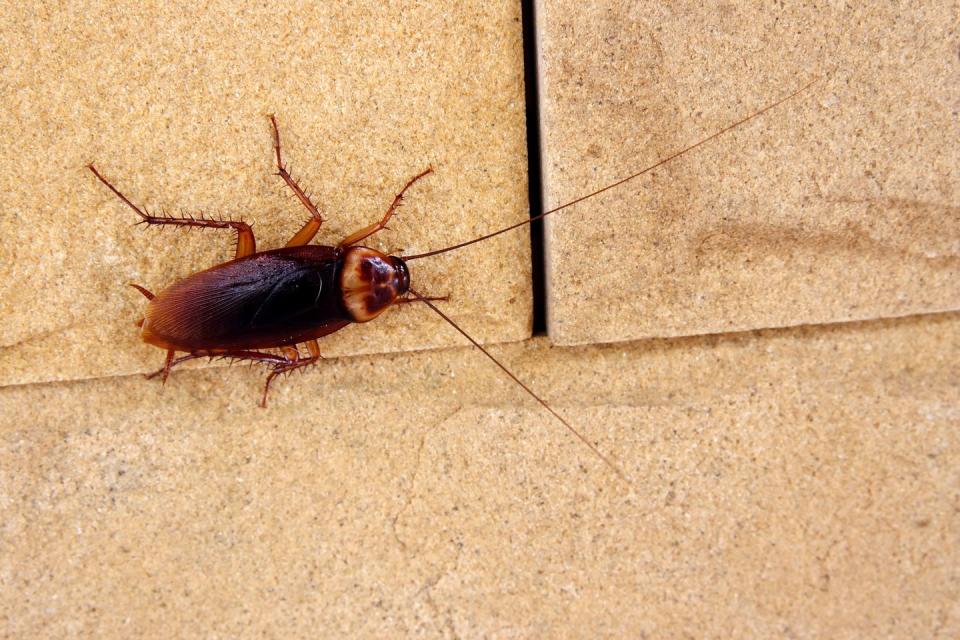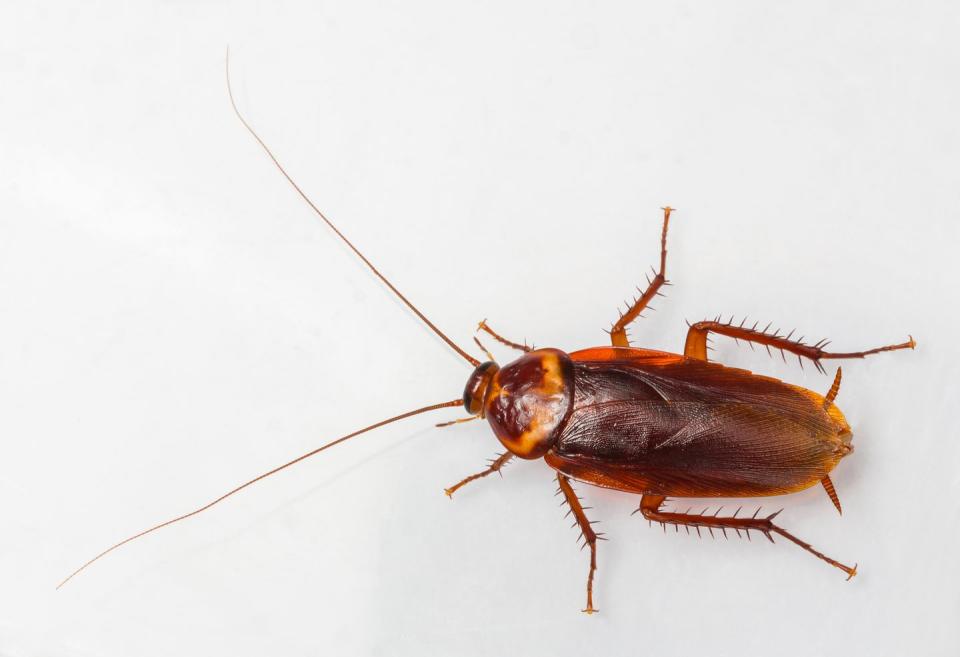“Bait Tacos” Are the Genius Method That Will Get Rid of Cockroaches for Good

"Hearst Magazines and Yahoo may earn commission or revenue on some items through the links below."
Cockroaches top the list of creepy-crawly things no one wants in their home. After all, they’re big, they’re fast, and trying to kill them with your foot always results in a loud “crunch”—yuck.
“There’s a big gross factor,” says Scott O’Neal, PhD, an urban entomology researcher at the University of Nebraska. “There’s always a lot of fear, especially if you’re not somebody who knows a lot about insects or, even worse, you grew up fearing them.”
The good news: Although they certainly aren’t something you want in your home, they don’t carry the same disease risks as blood-feeding insects like mosquitoes or ticks do, says O’Neal.
But depending on the type of cockroach you’re dealing with, how big the infestation is, and where they’re living in your home, getting rid of them can require a lot of work. Part of that is because one cockroach in particular—called the German cockroach, which is the most common type of cockroach in the U.S.—has become resistant to a lot of insecticides on the market.
“We have been spraying German roaches with every insecticide known to man since about the 1940s, and even before that,” says Dini Miller, PhD, professor of urban entomology at Virginia Tech and Urban Pest Management Specialist for the state of Virginia. “We’ve killed all the roaches that our sprays can kill, and we’ve selected for those that are genetically resistant to insecticides.”
What that means is that while you might kill some or even most German roaches with one insecticide application, you’re unlikely to get all of them with just one bout, since some of them have become mutants who can resist most of what you throw at them. But don’t panic: That doesn’t mean you’ll be stuck living with them forever. Here’s what to know about getting rid of cockroaches for good, no matter what kind you’re dealing with.
Back up: How do I tell what kind of cockroach I have in my home?

Suburban, free-standing homes
If you live in a private home, it’s extremely unlikely that you’d have an infestation of the German cockroach, says Coby Schal, PhD, who heads the Schal Lab at North Carolina State University, which focuses on the study of cockroaches.
In that case, you’re more likely to have what’s called a smoky brown cockroach, which is a very large cockroach that lives outdoors and is almost black in color. “When the outdoors gets a little nasty for the cockroach, like dry or cold, this cockroach tends to come into the home not because it likes to be in the home, but because it is looking for moisture, food, and a warm environment,” he says. Typically, this type will make its way in through things like firewood being brought into the home in the winter.
Smoky brown cockroaches won’t establish an infestation in your home because, similar to a house fly bumping against your windows to get out, it doesn’t really want to be there in the first place. It also doesn’t have the same insecticide resistance as the German cockroach, so getting rid of it will be much easier.

City apartments
Now, let’s say you live in a city on a lower-floor apartment and you spot a roach scattering in your bathroom. In that case, it’s likely you’re dealing with an American cockroach, which is the largest cockroach in North America at about 2 inches with a shiny and reddish exterior. Typically, they’re found in sewer systems. “So in many cities, I think of them as kind of floating on a mat of cockroaches because there’s a vast sewer network under us, and that sewer network is usually occupied with millions of these cockroaches,” says Schal.
Especially in the summer, American cockroaches will tend to come out of the sewer system to escape the heat and look for food, which means they might end up in your apartment. But lucky for you, similar to smoky brown cockroaches, American roaches don’t have the same resistance that German cockroaches do to insecticides, so killing them off will be a little more painless.

Inner-city apartments and housing
Finally, if you live in a city and have ruled out having an American cockroach infestation, it’s likely you’re dealing with a German cockroach infestation. German cockroaches are much smaller at only about ¾ of an inch and are best identified by the “racing stripes” they have on their pronotum, which is the plate behind their head, says Schal.
The German cockroach is also what’s called an “obligate associate” with humans, which means it only lives where humans are (lucky us!). “So it has evolved to completely abandon its natural habitat, whatever it was, and is strictly associated with humans and human-made structures,” says Schal. German cockroaches can be found pretty much anywhere, but they’re most commonly found in inner-city and low-income environments.
How to get rid of and kill cockroaches safely

1. Prevent them from coming into your home in the first place.
Your best bet is to keep roaches far away to begin with. “If you don’t provide an environment they can establish in, then you’re unlikely to get them,” says O’Neal.
That means if you want to avoid getting cockroaches altogether, make sure you regularly clean out areas like your garage, basement, and attic where you might have old cardboard, books, clothes, or other things boxed up. Those types of environments prove perfect for cockroaches, who like to feel sheltered and secure.
You can also manage your environment by not providing a food source for cockroaches. That means not keeping out food or dirty plates, and having trash and recycling bins that are well-contained. (Plus, denying food sources will help kill off any potential invaders already in your home). Finally, put door sweeps under your doors so cockroaches don’t have easy way to get inside.
2. Avoid using insecticide sprays.
Now, let’s say you do all of this (or maybe you went a month too long without vacuuming—it happens to all of us), and you discover a cockroach lurking in the crevice next to your fridge. That signals that it’s time to bring in insecticides.
But one hugely important thing to note here is this: Do not use insecticide sprays in your home. “Everybody has been told since the time they were a child that the way you kill insects is with a spray,” says Miller. “But we have different methods of killing them that we really need to use because we have sprayed ourselves into this genetic mutant situation.”
The same goes for bug bombs, called “total release foggers,” which have actually been proven to be completely ineffective against cockroaches, says Schal. Plus, using sprays or bug bombs is actually a huge danger for you and your family. “People often misuse them because they deploy many of these units per home, and that can result in fires, explosions, all kinds of nasty results,” says Schal.
3. Bring out the bait.
Instead, opt for a safer and much more effective option: baits, which are gel formulations that come in 30-millimeter syringe tubes. Ultimately, you’ll be using that bait to create what Miller calls “bait tacos.”
To make bait tacos, buy wax paper—Miller opts for the Cut-Rite version you can find at your local supermarket (or Amazon) that’s typically used for baking—and cut it into 2-inch squares. From there, fold it down diagonally—into a little mini “taco”—and put a line of gel bait down the diagonal line. “The wax paper kind of protects the bait from all the pesticide residues that have been applied in these apartments every month for the last 100 years,” says Miller. “And the cockroaches really like it.”
The reason it benefits you to use the wax paper to protect the bait is because you don’t want the cockroaches in your home to get sick from a previous pesticide or insecticide spray and not have the desire to eat your bait.
Finally, once you’re done making your “tacos,” place the bait in places where you’ve seen roaches appear (think: inside drawers, behind the refrigerator, or in other cracks and crevices in your home).
If you’re dealing with an American or smoky brown cockroach, this approach should do the trick by itself. “With literally $5 or maximum $10, you can eliminate an infestation in the home,” says Schal.
But if you’re dealing with German cockroaches, there’s a bit of a catch: You need to be rotating the gel bait formulations you apply in these “tacos” every 3 months, says Miller, so that the gels have different active and inert ingredients in them (more specifically, look for ones with fipronil, avermectin, or neonicotinoids as their active ingredient). That way, you’re targeting all the different mutations that could be occurring in your cockroach population.
4. Call in the pros.
If you’ve done this method and have completed multiple rotations but still have roaches crawling all over your home, then it’s time to call in the professionals. Because roaches can vary by area (and so can their resistance), a trained applicator will be better able to identify what the best route for nixing the cockroaches will be—and finally allow you some peace of mind.
Like what you just read? You’ll love our magazine! Go here to subscribe. Don’t miss a thing by downloading Apple News here and following Prevention. Oh, and we’re on Instagram too.
You Might Also Like
